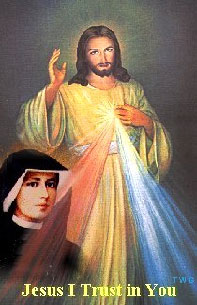|
 A WORD FROM THE PASTOR A WORD FROM THE PASTOR
St. Faustina and the Image of Divine Mercy
St. Faustina Kowalska of Poland is the well-known apostle of Divine Mercy. She invites us by the witness of her life to keep our faith and hope fixed on God the Father, rich in mercy, who saved us by the precious blood of his Son on this feast of Divine Mercy. During her short life, the Lord Jesus assigned to St. Faustina three basic tasks: 1. to pray for souls, entrusting them to God's incomprehensible Mercy; 2. to tell the world about God's generous Mercy; 3. to start a new movement in the Church focusing on God's Mercy.
At the canonization of Sister Faustina on 30th of April, 2000, Pope Francis said: “The cross, even after the Resurrection of the Son of God, speaks, and never ceases to speak, of God the Father, who is absolutely faithful to His eternal love for man… Believing in this love means believing in mercy."
The image of Divine Mercy is based on the vision given to St. Faustina. It shows Jesus raising his right hand in a gesture of blessing, with his left hand on his heart from which gush forth two rays, one red and one white. The picture contains the message, "Jesus, I trust in You!" The rays streaming out have symbolic meaning: red for the Blood of Jesus, which is the life of souls and white for the water of Baptism which justifies souls. The whole image is symbolic of the mercy, forgiveness and love of God.
Pope Francis published a document titled Misericordiae Vultus (The Mercy of the Father) for the Year of Mercy, celebrated from December 2015 to November 2016. He said, “God’s mercy is not merely a soothing ointment designed to make us feel better about our sins while still living in them. Rather, mercy is God’s way of reaching out to us, offering us a new chance to look at ourselves, to convert, to believe. Mercy is also the foundation of the church’s life – God’s mercy is what the church preaches; what the church dispenses in the Mass and the Sacraments; and what the church practices in works and charity, healing and education.”
In a world that all too often chooses violence and severity over mercy, we are called to be authentic signs and indeed missionaries of the Father’s mercy. Therefore, it is a challenge to all of us to be practitioners of mercy, not only by contributing to charitable efforts, but also in our personal lives. Let us practice act of mercy in us and with those whom we interact on daily basis.
How to Pray the Chaplet of The Divine Mercy
Divine
Mercy Prayers
Divine
Mercy Novena
In the Service of the Lord,
Father Thainese Alphonse |
|
|